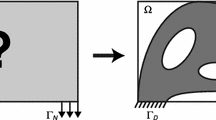Abstract
Mathematical optimization theories are employed for the design of structures in structural optimization. Structural optimization is being widely utilized for practical problems due to well-developed commercial software systems. Three representative structural optimization systems such as Genesis, MSC Nastran and OptiStruct are investigated and evaluated by solving various test examples in different scales. The design capabilities of three software systems are explored and the performances of the systems are compared. The performance of structural optimization depends on the quality of the optimum solution and the computational time, and these aspects are compared from an application viewpoint. For a fair comparison, the same formulations are utilized, and the same optimization methods are employed for each example. Also, the same system environment is prepared, and the same optimization parameters are used. Additionally, various design options of each software system are tested for the best performance. Linear static response size, shape, topology, topometry and topography optimizations are applied to the examples and the results are compared. No system seems to be the best in all cases and each system has advantages and disadvantages depending on the application. In general, Genesis is excellent in computational time while OptiStruct gives excellent optimum solutions, in size, topometry and topology optimizations. Meanwhile, MSC Nastran presents good solutions in shape and topography optimizations.



















Similar content being viewed by others
References
Altair HyperStudy tutorials version 13.0 (2014) Altair Engineering, Inc., MI, USA
Altair OptiStruct user’s manual version 13.0 (2014) Altair Engineering, Inc., MI, USA
ANSYS http://www.ansys.com/About+ANSYS ANSYS, Inc
Arora JS (2012) Introduction to optimum design. Elsevier, Waltham
Bathe KJ (1996) Finite element procedures in engineering analysis. Prentice Hall, Englewood Cliffs
Bendsøe MP, Sigmund O (2003) Topology optimization theory, methods and applications Springer, Germany
Choi WS, Park GJ (2002) Structural optimization using equivalent static loads at all the time intervals. Comput Methods Appl Mech Eng 191:2105–2122
Cook R, Malkus D, Plesha M, Witt R (2001) Concepts and applications of finite element analysis. Wiley, USA
Diaz AR, Sigmund O (1995) Checkerboard patterns in layout optimization. Struct Optim 10:40–45
Fleury C (1989) CONLIN: an efficient dual optimizer based on convex approximation concepts. Mechanical, aerospace and nuclear engineering department. University of California, USA
Fleury C, Braibant V (1986) A new dual method using mixed variables. Int J Numer Methods Eng 23(3):409–428
Genesis http://www.vrand.com/companyProfile.html Vanderplaats Research and Development, Inc
Genesis user’s manual version 13.1 design reference (2014) Vanderplaats Research and Development. Inc. Colorado Springs, USA
Haftka RT, Gürdal Z (1992) Elements of structural optimization. Kluwer, Dordrecht
Haug EJ, Arora JS (1979) Applied optimal design. NY, USA
Hong UP, Hwang KH, Park GJ (2004) A comparative study of software systems from the optimization viewpoint. Struct Multidiscip Optim 27(6):460–468
HyperWorks http://www.altairhyperworks.com/ Altair Engineering, Inc
Kim YI, Park GJ (2010) Nonlinear dynamic response structural optimization using equivalent static loads. Comput Methods Appl Mech Eng 199:660–676
Lee HA, Jung SB, Jang HH, Shin DH, Lee JW, Kim KW, Park GJ (2015) Structural-optimization-based design process for the body of a railway vehicle made from extruded aluminium panels. Proc IMechE Part F: J Rail Rapid Transit. doi:10.1177/0954409715593971
Lim JH, Kim KW, Kim SW, Hwang DS (2009) Technology trends on structural analysis software in aerospace industry. Current Industrial Tech Trends Aerospace 7(2):59–67
Logan DL (1993) A first course in the finite element method. PWS publishing company, Boston
MSC Nastran user’s guide automated structural optimization in MSC Nastran version 2014 (2014c) MSC Software Co., Newport Beach, CA, USA
MSC Nastran user’s guide design sensitivity and optimization version 2013 (2013b) MSC Software Co., Santa Ana, CA, USA
MSC Nastran user’s guide version 2013.1.1 (2013a) MSC Software Co., Newport Beach, CA, USA
OptiStruct http://www.altairhyperworks.com/Product,19,OptiStruct.aspx Altair Engineering, Inc
Park GJ (2007) Analytical methods in design practice. Springer, Germany
Park GJ (2011) Technical overview of the equivalent static loads method for non-linear static response structural optimization. Struct Multidiscip Optim 43:319–337
Park YS, Lee SH, Park GJ (1995) A study of direct vs. approximation methods in structural optimization. Structural Optimization 10:64–66
Patran user’s guide version 2014 (2014) MSC Software Co., Newport Beach, CA, USA
Schmit LA (1960) Structural design by systematic synthesis. Proceedings of the second ASCE conference, NY, 105–122
Shin MK, Park KJ, Park GJ (2007) Optimization of structures with nonlinear behavior using equivalent loads. Comput Methods Appl Mech Eng 196:1154–1167
Tosca http://www.3ds.com/products-services/simulia/products/tosca/ Dassault systems
Vanderplaats GN (1973) CONMIN – a Fortran program for constrained function minimization: user’s manual. NASA TM X-62282
Vanderplaats GN (1999) Numerical optimization techniques for engineering design. Vanderplaats Research and Development. Inc, Colorado Springs
Vanderplaats GN (2000) Very large scale optimization. The eighth AIAA/USAF/NASA/ISSMO symposium at multidisciplinary analysis and optimization, Long Beach, CA, USA
Zhou M, Shyy YK, Thomas HL (2001) Checkerboard and minimum member size control in topology optimization. Struct Multidiscip Optim 21:152–158
Acknowledgments
This research was supported by the Guangdong Provincial Natural Science Foundation (2015A030312008) and Guangdong Provincial Science and Technology Plan (2015B010104006). The authors are thankful to Mrs. MiSun Park for the English correction of the manuscript.
Author information
Authors and Affiliations
Corresponding author
Rights and permissions
About this article
Cite this article
Choi, Wh., Kim, Jm. & Park, GJ. Comparison study of some commercial structural optimization software systems. Struct Multidisc Optim 54, 685–699 (2016). https://doi.org/10.1007/s00158-016-1429-y
Received:
Revised:
Accepted:
Published:
Issue Date:
DOI: https://doi.org/10.1007/s00158-016-1429-y




